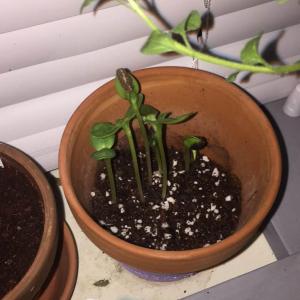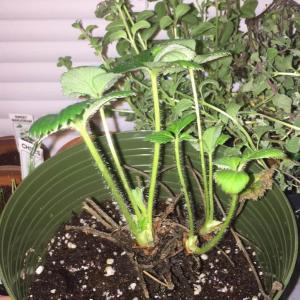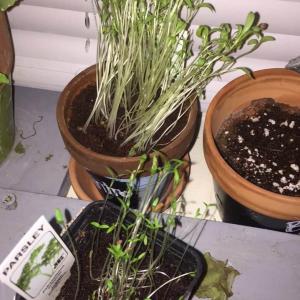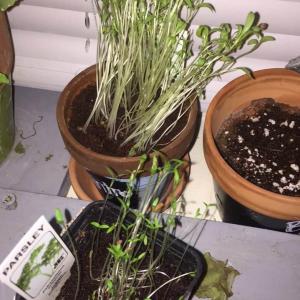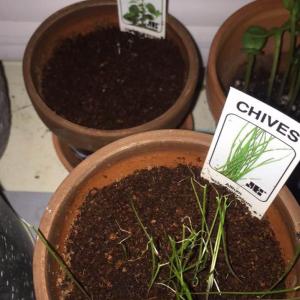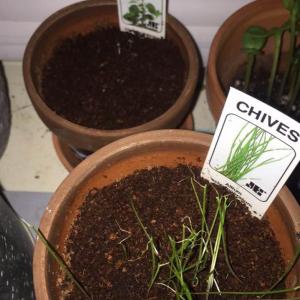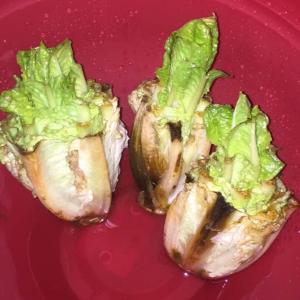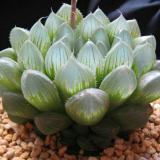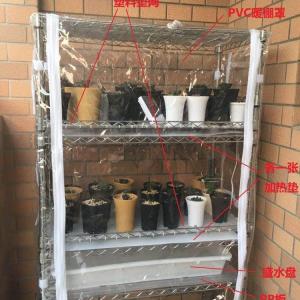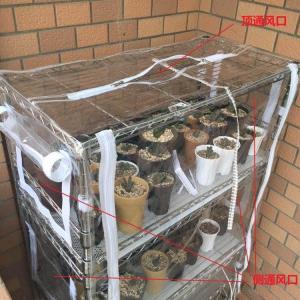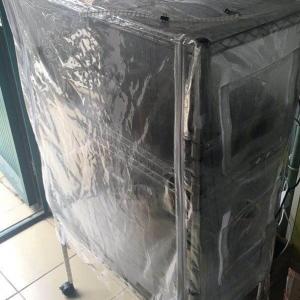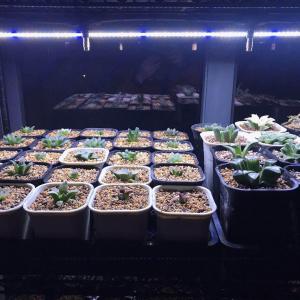文章
Miss Chen
2018年02月02日

Description: This wildflower is a biennial or short-lived perennial plant that is ½–1' tall when it blooms. The basal leaves persist during most of the year, although they may die down during the winter. They are ¾-2" long, ½-1" across, broadly elliptic to oval-obovate in shape, and either finely serrated or slightly dentate along their margins. The slender petioles of the basal leaves are ½-1" long and light green; they often have cobwebby hairs. The blade surface of the basal leaves is medium green and sparsely covered with mealy hairs. Unbranched flowering stalks develop among the basal leaves. These stalks are light green, terete to slightly channeled, and more or less covered with cobwebby hairs. Alternate leaves are sparsely distributed along each flowering stalk; they are up to 1¼" long and ¼" across. The alternate leaves are medium green, narrowly pinnatifid, and more or less covered with cobwebby hairs, particularly along the lower side of their central veins and along their petioles.
The central stalk terminates in a flat-headed cluster of 3-12 flowerheads. Each daisy-like flowerhead is about ½" across, consisting of 8-14 ray florets surrounding numerous disk florets that are yellow or golden yellow. The petaloid rays of the flowerheads are yellow and narrowly oblong. Around the base of each flowerhead, there are light green floral bracts (phyllaries) that are arranged together in a single series. They are oblong-linear in shape and more or less covered with cobwebby hairs. The blooming period occurs from mid- to late spring, lasting about 3-4 weeks. The flowerheads are mildly fragrant. About a month after the blooming period, the achenes mature, developing tufts of white hairs; they are dispersed by the wind. The root system is fibrous and rhizomatous. Prairie Ragwort often forms clonal colonies from its rhizomes.

Cultivation: The preference is full sun, mesic to dry conditions, and soil containing loam, clay-loam, sand, or gravelly material. Prairie Ragwort tends to favor less fertile soil because of the reduced competition from other plants. The basal leaves are semi-evergreen and they have few problems with disease.
Range & Habitat: The native Prairie Ragwort occurs primarily in the northern half of Illinois and in counties that are located along major rivers. It is occasional to locally common in the northern and western sections of the state, while elsewhere it is uncommon or absent (see Distribution Map). Habitats include upland prairies, gravel prairies, sand prairies, hill prairies, bluffs overlooking major rivers, openings in either rocky or sandy upland forests, sandy savannas, limestone glades, and roadside embankments. This little plant is usually found in open grassy areas. It blooms during the spring before the warm-season prairie grasses have achieved much growth.

Faunal Associations: Flies and small bees are the most common visitors to the flowers. Among the bee visitors, are little carpenter bees (Ceratina spp.), cuckoo bees (Nomada spp.), Halictid bees (Augochlorella spp., Halictus spp., Lasioglossum spp.), and Andrenid bees (Andrena spp.), including the oligolectic bee Andrena gardineri. Other floral visitors include Syrphid flies, Tachinid flies, thick-headed flies, skippers, and small butterflies. These insects are attracted to the nectar and pollen of the flowers. Polyphagous caterpillars of the moth Orthonama obstipata (The Gem) feed on the foliage of ragworts (Packera spp.); this moth dies out in Illinois during the winter, but it rapidly repopulates the state from the south when warm weather returns. Ragworts are preferred host plants of the seed bug, Neacoryphus bicrucis. The foliage is highly toxic to mammalian herbivores, especially cattle, and to a lesser extent horses and sheep. It contains pyrrolizidine alkaloids that can damage the liver and cause other health problems.

Photographic Location: The photographs were taken at Meadowbrook Park in Urbana, Illinois.
Comments: This is a perky little plant with bright yellow flowerheads. Among the various ragworts (Packera spp.) in Illinois, Prairie Ragwort is the most drought tolerant. It also has more cobwebby hairs on its flowering stalks and leaves than other ragworts, although these hairs gradually disappear after the blooming period. A scientific synonym of Prairie Ragwort is Senecio plattensis. The 'ragwort' in the common name probably refers to the ragged appearance of alternate leaves on the flowering stalks.
The central stalk terminates in a flat-headed cluster of 3-12 flowerheads. Each daisy-like flowerhead is about ½" across, consisting of 8-14 ray florets surrounding numerous disk florets that are yellow or golden yellow. The petaloid rays of the flowerheads are yellow and narrowly oblong. Around the base of each flowerhead, there are light green floral bracts (phyllaries) that are arranged together in a single series. They are oblong-linear in shape and more or less covered with cobwebby hairs. The blooming period occurs from mid- to late spring, lasting about 3-4 weeks. The flowerheads are mildly fragrant. About a month after the blooming period, the achenes mature, developing tufts of white hairs; they are dispersed by the wind. The root system is fibrous and rhizomatous. Prairie Ragwort often forms clonal colonies from its rhizomes.

Cultivation: The preference is full sun, mesic to dry conditions, and soil containing loam, clay-loam, sand, or gravelly material. Prairie Ragwort tends to favor less fertile soil because of the reduced competition from other plants. The basal leaves are semi-evergreen and they have few problems with disease.
Range & Habitat: The native Prairie Ragwort occurs primarily in the northern half of Illinois and in counties that are located along major rivers. It is occasional to locally common in the northern and western sections of the state, while elsewhere it is uncommon or absent (see Distribution Map). Habitats include upland prairies, gravel prairies, sand prairies, hill prairies, bluffs overlooking major rivers, openings in either rocky or sandy upland forests, sandy savannas, limestone glades, and roadside embankments. This little plant is usually found in open grassy areas. It blooms during the spring before the warm-season prairie grasses have achieved much growth.

Faunal Associations: Flies and small bees are the most common visitors to the flowers. Among the bee visitors, are little carpenter bees (Ceratina spp.), cuckoo bees (Nomada spp.), Halictid bees (Augochlorella spp., Halictus spp., Lasioglossum spp.), and Andrenid bees (Andrena spp.), including the oligolectic bee Andrena gardineri. Other floral visitors include Syrphid flies, Tachinid flies, thick-headed flies, skippers, and small butterflies. These insects are attracted to the nectar and pollen of the flowers. Polyphagous caterpillars of the moth Orthonama obstipata (The Gem) feed on the foliage of ragworts (Packera spp.); this moth dies out in Illinois during the winter, but it rapidly repopulates the state from the south when warm weather returns. Ragworts are preferred host plants of the seed bug, Neacoryphus bicrucis. The foliage is highly toxic to mammalian herbivores, especially cattle, and to a lesser extent horses and sheep. It contains pyrrolizidine alkaloids that can damage the liver and cause other health problems.

Photographic Location: The photographs were taken at Meadowbrook Park in Urbana, Illinois.
Comments: This is a perky little plant with bright yellow flowerheads. Among the various ragworts (Packera spp.) in Illinois, Prairie Ragwort is the most drought tolerant. It also has more cobwebby hairs on its flowering stalks and leaves than other ragworts, although these hairs gradually disappear after the blooming period. A scientific synonym of Prairie Ragwort is Senecio plattensis. The 'ragwort' in the common name probably refers to the ragged appearance of alternate leaves on the flowering stalks.
0
0
文章
Miss Chen
2018年02月02日

Description: This perennial wildflower consists of a small rosette of basal leaves spanning 2-4" across, from which there develops a single stalk of flowerheads about 6-14" tall. The basal leaves are 1½-3" long and ½-¾" across (at least twice as long as across); they are oblong-elliptic to oblong-lanceolate in shape and crenate-serrate along their margins. The teeth along the margins have blunt tips and they vary in size from large and coarse to small and fine. The upper and lower surfaces of the basal leaves are medium green and glabrous (or nearly so); young basal leaves are sometimes sparsely hairy or white-mealy. The petioles of the basal leaves are about one-half the length of the blades and relatively narrow; they are light green to pale purple and glabrous. The central stalk is light green to purple and glabrous (or nearly so); sometimes it has sparse cobwebby hairs toward the bottom. Along this stalk, there are 2-4 alternate leaves; they are up to 2½" long and ½" across, becoming smaller as they ascend the stalk. The alternate leaves are narrowly lanceolate-oblong, pinnatifid with cleft lobes, and/or coarsely dentate along their margins; they are sessile. The upper and lower surfaces of the alternate leaves are medium green and glabrous.
The central stalk terminates in a flat-headed panicle of 5-30 flowerheads. Each daisy-like flowerhead spans about ½-¾" across, consisting of 40 or more disk florets and 8-13 ray florets (rarely none); the disk and ray florets are both perfect and fertile. The corollas of the disk florets are deep golden yellow, cylindrical in shape, and 5-lobed. The petaloid extensions of the ray florets are yellow and linear-oblong in shape. Around the base of each flowerhead, there are several phyllaries (floral bracts) in a single series; they are about ¼" long. These phyllaries are linear in shape, glabrous, and mostly light green, except toward their tips, where they become pale purple. The branches and peduncles of the inflorescence are light green to pale purple and glabrous; there are often tiny bractlets where they diverge. These bractlets are scale-like and purple. The blooming period occurs from mid-spring to early summer, lasting about 3 weeks. Afterwards, the florets are replaced by small achenes with sessile tufts of white hair. These achenes are 1-2 mm. long and bullet-shaped. The root system consists of a short crown of fibrous roots and occasional rhizomes or stolons. Occasionally, clonal colonies of plants are produced from the rhizomes or stolons.
Cultivation: The preference is full or partial sun, moist conditions, and soil containing loam, sandy loam, or rocky material. Most growth and development occurs during the spring. The basal leaves persist throughout the warmer months into winter.

Range & Habitat: The native Balsam Ragwort is occasional in the northern half of Illinois, becoming rare or absent in the southern half of the state (see Distribution Map). Habitats include moist sand prairies, prairie remnants along railroads, sedge meadows, streambanks, moist sandy savannas, open woodlands, and abandoned fields. Areas with low ground vegetation and some history of disturbance are preferred.
Faunal Associations: The nectar and pollen of the flowerheads attract a variety of small to medium-sized insects, including cuckoo bees (Nomada spp.), Halictid bees, Andrenid bees, Syrphid flies, small butterflies and skippers, and miscellaneous beetles. An Andrenid bee, Andrena gardineri, is a specialist pollinator (oligolege) of Packera spp. (ragworts). Some insects feed on the foliage or seeds of ragworts. These species include caterpillars of the moth Agonopterix canadensis (Canadian Agonopterix) and the seed bug Neacoryphus bicrucis. The foliage of ragworts is toxic to most mammalian herbivores, causing liver damage.
Photographic Location: Along a bike path through a sand prairie at the Indiana Dunes National Lakeshore in NW Indiana.

Comments: As compared to the similar Prairie Ragwort (Packera plattensis), this ragwort prefers habitats that are more moist. Balsam Ragwort differs from the former species by its glabrous foliage and more narrow basal leaves. The basal leaves of other perennial ragworts (Packera spp.) in Illinois have basal leaves that are more broad. However, across its range, Balsam Ragwort is rather variable, possibly because of hybridization with similar species. The perennial ragworts in Illinois all bloom during the spring or early summer and they have showy yellow flowerheads. The annual and biennial ragworts in Illinois are mostly from Eurasia and they have less showy flowerheads. An exception is the native Butterweed (Packera glabella). This latter species is usually taller than the perennial ragworts and it lacks their conspicuous basal leaves during the blooming period. A scientific synonym of Balsam Ragwort is Senecio pauperculus; another common name of this species is Northern Ragwort.
The central stalk terminates in a flat-headed panicle of 5-30 flowerheads. Each daisy-like flowerhead spans about ½-¾" across, consisting of 40 or more disk florets and 8-13 ray florets (rarely none); the disk and ray florets are both perfect and fertile. The corollas of the disk florets are deep golden yellow, cylindrical in shape, and 5-lobed. The petaloid extensions of the ray florets are yellow and linear-oblong in shape. Around the base of each flowerhead, there are several phyllaries (floral bracts) in a single series; they are about ¼" long. These phyllaries are linear in shape, glabrous, and mostly light green, except toward their tips, where they become pale purple. The branches and peduncles of the inflorescence are light green to pale purple and glabrous; there are often tiny bractlets where they diverge. These bractlets are scale-like and purple. The blooming period occurs from mid-spring to early summer, lasting about 3 weeks. Afterwards, the florets are replaced by small achenes with sessile tufts of white hair. These achenes are 1-2 mm. long and bullet-shaped. The root system consists of a short crown of fibrous roots and occasional rhizomes or stolons. Occasionally, clonal colonies of plants are produced from the rhizomes or stolons.
Cultivation: The preference is full or partial sun, moist conditions, and soil containing loam, sandy loam, or rocky material. Most growth and development occurs during the spring. The basal leaves persist throughout the warmer months into winter.

Range & Habitat: The native Balsam Ragwort is occasional in the northern half of Illinois, becoming rare or absent in the southern half of the state (see Distribution Map). Habitats include moist sand prairies, prairie remnants along railroads, sedge meadows, streambanks, moist sandy savannas, open woodlands, and abandoned fields. Areas with low ground vegetation and some history of disturbance are preferred.
Faunal Associations: The nectar and pollen of the flowerheads attract a variety of small to medium-sized insects, including cuckoo bees (Nomada spp.), Halictid bees, Andrenid bees, Syrphid flies, small butterflies and skippers, and miscellaneous beetles. An Andrenid bee, Andrena gardineri, is a specialist pollinator (oligolege) of Packera spp. (ragworts). Some insects feed on the foliage or seeds of ragworts. These species include caterpillars of the moth Agonopterix canadensis (Canadian Agonopterix) and the seed bug Neacoryphus bicrucis. The foliage of ragworts is toxic to most mammalian herbivores, causing liver damage.
Photographic Location: Along a bike path through a sand prairie at the Indiana Dunes National Lakeshore in NW Indiana.

Comments: As compared to the similar Prairie Ragwort (Packera plattensis), this ragwort prefers habitats that are more moist. Balsam Ragwort differs from the former species by its glabrous foliage and more narrow basal leaves. The basal leaves of other perennial ragworts (Packera spp.) in Illinois have basal leaves that are more broad. However, across its range, Balsam Ragwort is rather variable, possibly because of hybridization with similar species. The perennial ragworts in Illinois all bloom during the spring or early summer and they have showy yellow flowerheads. The annual and biennial ragworts in Illinois are mostly from Eurasia and they have less showy flowerheads. An exception is the native Butterweed (Packera glabella). This latter species is usually taller than the perennial ragworts and it lacks their conspicuous basal leaves during the blooming period. A scientific synonym of Balsam Ragwort is Senecio pauperculus; another common name of this species is Northern Ragwort.
0
0
文章
Miss Chen
2018年02月02日

Description: This perennial wildflower is 1-2½' tall, branching occasionally. The stems are terete and either glabrous or slightly pubescent. Alternate trifoliate leaves occur along the stems on petioles that are ½-2" in length. At the base of each petiole, there is a pair of narrowly lanceolate stipules less than ¼" long. The rather narrow leaflets are 1-3" long and ¼-¾" across; they are ellipsoid to oblong in shape and smooth along their margins. The upper surfaces of the leaflets are medium green and hairless (or nearly so). In each trifoliate leaf, the lateral leaflets are nearly sessile, while the terminal leaflet has a short petiolule (stalklet) at its base. Spike-like racemes of flowers about 1½–4" long develop from some of the leaf axils. These racemes are held more or less erect above the foliage on long naked peduncles about 3-6" long. The peduncles are glabrous or slightly pubescent. The flowers are arranged somewhat densely all around the raceme; they vary in color from blue-violet to white. Usually, the buds near the apex of a raceme are more blue-violet than the flowers in bloom below, which tend to be more white. Individual flowers are ¼" long, consisting of 5 petals, a short tubular calyx with 5 teeth, and the reproductive organs. The arrangement of the petals is typical for species in the Bean family: there is an upright banner and a pair of lateral wings that project forward to enclose the keel (consisting of two smaller petals).

The blooming period occurs from early to mid-summer and lasts about 3 weeks. The flowers are replaced by small seedpods (a little less than ¼" in length) that are flattened and nearly circular in shape. The sides of each pod have transverse wrinkles. Each seedpod contains a single seed. The root system consists of a taproot.
Cultivation: The preference is full or partial sun, mesic to dry conditions, and an acidic soil that is sandy or rocky.
Range & Habitat: The native Sampson's Snakeroot is occasional in southern Illinois, while in the rest of the state it is absent (see Distribution Map). Illinois lies along the northern range limit for this flowering plant. Habitats include mesic to dry prairies, sand prairies, sandstone glades, rocky upland woodlands, savannas, and thinly wooded bluffs. This wildflower benefits from occasional disturbance that reduces the encroachment of woody vegetation.
Faunal Associations: In general, very little is known about floral-faunal relationships for this species. The flowers are pollinated primarily by bees, which seek nectar and pollen. A Carder bee, Anthidium psoraleae, is one of the bee visitors of the flowers; it is a weak oligolege (specialist pollinator) of flowering plants in the Fabaceae (Bean family). A similar species, Anthidium maculifrons, may be another oligolectic visitor of the flowers. The caterpillars of the moth, Cyclophora pendulinaria (Sweetfern Geometer), have been observed to feed on Sampson's Snakeroot.
Photographic Location: The flowering plants were photographed by Keith & Patty Horn (Copyright © 2009) at a prairie in Fayette County, Illinois. The trifoliate leaf was photographed by the webmaster at the top of a semi-shaded sandstone cliff in southern Illinois.
Comments: Sampson's Snakeroot is a fairly typical example of a species in the Bean family: it has trifoliate leaves and racemes of pea-like flowers. The seedpods are perhaps its most unusual feature: they are nearly circular in shape and contain a single seed. More typically, the seedpods of species in this family are more elongated in shape and contain several seeds. In Illinois, the closest relative of Sampson's Snakeroot is Orbexilum onobrychis (Sanfoin), which is found in habitats that are more moist (e.g., river-bottom prairies). This latter species is larger in size (3-4' tall) than Sampson's Snakeroot, its leaflets are more wide (often exceeding 1" across), and its flowers are usually a deeper shade of blue-violet. Another similar species, Psoralidium tenuiflorum (Scurfy Pea), has palmately compound leaves with as many as 5 leaflets and the flowers of its racemes are more loosely arranged on shorter peduncles. An older scientific name of Sampson's Snakeroot is Psoralea psoralioides.

The blooming period occurs from early to mid-summer and lasts about 3 weeks. The flowers are replaced by small seedpods (a little less than ¼" in length) that are flattened and nearly circular in shape. The sides of each pod have transverse wrinkles. Each seedpod contains a single seed. The root system consists of a taproot.
Cultivation: The preference is full or partial sun, mesic to dry conditions, and an acidic soil that is sandy or rocky.
Range & Habitat: The native Sampson's Snakeroot is occasional in southern Illinois, while in the rest of the state it is absent (see Distribution Map). Illinois lies along the northern range limit for this flowering plant. Habitats include mesic to dry prairies, sand prairies, sandstone glades, rocky upland woodlands, savannas, and thinly wooded bluffs. This wildflower benefits from occasional disturbance that reduces the encroachment of woody vegetation.
Faunal Associations: In general, very little is known about floral-faunal relationships for this species. The flowers are pollinated primarily by bees, which seek nectar and pollen. A Carder bee, Anthidium psoraleae, is one of the bee visitors of the flowers; it is a weak oligolege (specialist pollinator) of flowering plants in the Fabaceae (Bean family). A similar species, Anthidium maculifrons, may be another oligolectic visitor of the flowers. The caterpillars of the moth, Cyclophora pendulinaria (Sweetfern Geometer), have been observed to feed on Sampson's Snakeroot.
Photographic Location: The flowering plants were photographed by Keith & Patty Horn (Copyright © 2009) at a prairie in Fayette County, Illinois. The trifoliate leaf was photographed by the webmaster at the top of a semi-shaded sandstone cliff in southern Illinois.
Comments: Sampson's Snakeroot is a fairly typical example of a species in the Bean family: it has trifoliate leaves and racemes of pea-like flowers. The seedpods are perhaps its most unusual feature: they are nearly circular in shape and contain a single seed. More typically, the seedpods of species in this family are more elongated in shape and contain several seeds. In Illinois, the closest relative of Sampson's Snakeroot is Orbexilum onobrychis (Sanfoin), which is found in habitats that are more moist (e.g., river-bottom prairies). This latter species is larger in size (3-4' tall) than Sampson's Snakeroot, its leaflets are more wide (often exceeding 1" across), and its flowers are usually a deeper shade of blue-violet. Another similar species, Psoralidium tenuiflorum (Scurfy Pea), has palmately compound leaves with as many as 5 leaflets and the flowers of its racemes are more loosely arranged on shorter peduncles. An older scientific name of Sampson's Snakeroot is Psoralea psoralioides.
0
0
文章
Miss Chen
2018年02月01日

Description: This perennial plant is ¾–2' tall. It consists of a single pad (swollen stem) that is partially inserted in the ground, from which 1-2 additional sessile pads may develop from its upper curved margin. These fleshy pads are usually erect or ascending, although sometimes they sprawl horizontally. Individual pads are 2-7" long, 1½–5" across, and ½–1¼" thick; they are obovoid in shape and somewhat flattened. The pad surfaces are medium green or bluish green, shiny or dull, and hairless (excluding the woolly hair, bristles, and spines of areoles). The pads are evergreen during the winter, although they often become slightly yellowish and wrinkled at this time. Areoles (air pores) are scattered across the surface of each pad in diagonal rows; they often have a brownish appearance. Areoles have small tufts of fine sharp bristles (glochids) up to 3 mm. long that are embedded in woolly hairs. In addition, 0-2 hardened spines develop from each areole. The spines are light gray to light brown, straight, and variable in length (½–4" long). There are also small leaves near the areoles (one leaf per areole); these leaves are green or pale brown, about 3-6 mm. long, awl-shaped (subulate), and early-deciduous.
One or more flower buds can develop along the upper curved margin of each pad. These flower buds are up to 2" long and ¾" across; they are oblanceoloid-oblongoid in shape, greenish, and somewhat fleshy-scaly in appearance. When the flowers are fully open, they are 2-3" across. Each flower several tepals, numerous stamens, and an inferior ovary with a single style. Mature tepals are light yellow to yellow and satiny in appearance. Sometimes, the bases of inner tepals toward the center of each flower are orange-red. The filaments of the stamens are yellow to pale orange, while their anthers are yellow. At the apex of the style, there is a narrow ring of short stigmas; these stigmas are white. to pale yellow. The blooming period occurs during early summer, lasting about 3-4 weeks for a colony of plants. Each flower is diurnal, lasting only a single day. Afterwards, the flowers are replaced by sessile fruits. Mature fruits are 1¼–2" long and ½–¾" across, dull red to reddish brown, and oblanceoloid-oblongoid in shape with concave apices. Each fruit contains several seeds in a fleshy interior. Depending on the local ecotype and stage of ripeness, the flesh of these fruits is green to red and either sour, bland, or sweet.

Individual seeds are about 4 mm. long, tan to dark brown, globoid, and somewhat flattened in shape; there is narrow ridge along at least one-half of the outer margin of each seed. The root system is fibrous and spreading. Upper pads occasionally break off from lower pads, falling to the ground. Such detached pads can develop new roots in the ground, creating new plants that are clonal offsets.
Cultivation: The preference is full to partial sunlight (at least one-half day of sun), mesic to dry conditions, and sandy or rocky soil. Soil containing loam or clay-loam is tolerated if it is well-drained. Older stems on the ground have a tendency to become brown and woody with age, which is natural. It is faster and easier to start new plants using pads, rather than seeds; detached pads form new roots in the ground readily. This is the easiest cactus to grow in Illinois because of its tolerance of moisture, humidity, and cold winter weather. It also blooms more reliably than most cacti.

Range & Habitat: The Eastern Prickly Pear occurs occasionally in about one-half of the counties in Illinois (see Distribution Map). It is most likely to be found in sandy or hilly areas along the Mississippi and Illinois rivers, in hilly areas of southern Illinois, and sandy or rocky areas of northern Illinois. This is by far the most common cactus in Illinois. Most populations of this plant are native, although some local populations are the result of restoration efforts or occasional escapes from cultivation. Typical habitats include openings in sandy woodlands, sandy savannas, sand prairies, hill prairies, gravel prairies, barrens and rocky bluffs, sandstone and limestone glades, sand dunes along Lake Michigan and other areas, rocky or sandy slopes along major rivers and lakes, sandy cemeteries, pastures, and sandy or gravelly areas along railroads. The greatest threats to the survival of this plant are the destruction of habitat by modern development and the invasion of its habitat by woody vegetation.

Faunal Associations: Both long-tongued and short-tongued bees visit the flowers, including bumblebees, the Large Carpenter Bee (Xylocopa virginica), digger bees (Melissodes spp.), leaf-cutting bees (Megachile spp.), Halictid bees (including green metallic bees), and plasterer bees (Colletes spp.). Long-tongued bees suck nectar or collect pollen, while short-tongued bees collect pollen only; the larger bees are more likely to cause cross-pollination (Mitchell, 1960/1962; Kevan & Aiello, 2002). Some insects feed on the pads of Eastern Prickly Pear and other prickly pears (Opuntia spp.). These species include larvae of the Eastern Cactus-boring Moth (Melitara prodenialis); larvae of a polyphagous moth, Julia's Dicymolomia (Dicymolomia julianalis); larvae of another polyphagous moth, the Arge Tiger Moth (Grammia arge); and larvae of a Syrphid fly, Copestylum vittatum. Other insects suck plant juices from the pads or fruits of these plants. These species include the Prickly Pear Cactus Bug (Chelinidea vittiger), Pale-margined Stink Bug (Chlorochloa persimilis), and Uhler's Stink Bug (Chlorochroa uhleri). Some of these insects are found in the Great Plains region and SE United States, but not in the Midwest. See Needham et al. (1928), Covell (1984/2005), Hart & Gleason (1907), Froeschner (1942), Vestal (1913), and Rider (2009) for more information.

In the Eastern states, the relationships of prickly pears with vertebrate wildlife are less well-known than in western United States. From studies in these western areas, the fruits and seeds of these plants are eaten occasionally by the Wild Turkey and Thirteen-lined Ground Squirrel. Both the fruits and pads are eaten occasionally by the Coyote, Gray Fox, Cottontail Rabbit, Striped Skunk, and White-tailed Deer, notwithstanding the presence of bristles and occasional spines (Martin et al., 1951/1961). The fruits and pads are also eaten by the Ornate Box Turtle (Ernst et al., 1994); this turtle is often found in sand prairies. All of these vertebrate animals occur in Illinois at the present time. Domesticated animals, such as cattle, horses, and sheep, normally avoid the consumption of the fruits and pads of the Eastern Prickly Pear because of its spines and bristles. However, when these plants are eaten by such animals, the spines and bristles can irritate and damage both their mouth parts and digestive tracts (Georgia, 1913). When White-tailed Deer (and probably other vertebrate animals) eat the fruits, they help to spread the seeds to new locations (Myers et al., 2004). The relatively large pads of Eastern Prickly Pear provide nesting habitat for the Bobwhite Quail (Hernandez et al., 2003), and protective cover for snakes and other kinds of wildlife.

Photographic Location: The photographs were taken at a sandy meadow near Kickapoo State Park in Vermilion County, Illinois, and at a sand prairie of the Indiana Dunes National Lakeshore in NW Indiana.
Comments: The Eastern Prickly Pear (Opuntia humifusa) is a striking plant with large beautiful flowers. It has fewer spines than many western species of prickly pear (Opuntia spp.), but they are still fairly formidable. The fine bristles near the areoles can easily penetrate the skin, causing irritation should the pads of this cactus be carelessly handled or brushed against. While Eastern Prickly Pear normally occurs as scattered individual plants or in small colonies, sometimes this cactus can form impressively large colonies if it persists at the same location for a sufficiently long period of time. The only other cactus with a similar size and appearance in Illinois is the less common Big-rooted Prickly Pear (Opuntia macrorhiza). This latter species differs from the Eastern Prickly Pear by its thick tuberous root and the greater abundance of spines on its pads. While Eastern Prickly Pear develops 0-2 spines per areole, Big-rooted Prickly Pear develops 2 or more spines per areole. Other scientific names that refer to Eastern Prickly Pear include Opuntia compressa and Opuntia rafinesquei.
One or more flower buds can develop along the upper curved margin of each pad. These flower buds are up to 2" long and ¾" across; they are oblanceoloid-oblongoid in shape, greenish, and somewhat fleshy-scaly in appearance. When the flowers are fully open, they are 2-3" across. Each flower several tepals, numerous stamens, and an inferior ovary with a single style. Mature tepals are light yellow to yellow and satiny in appearance. Sometimes, the bases of inner tepals toward the center of each flower are orange-red. The filaments of the stamens are yellow to pale orange, while their anthers are yellow. At the apex of the style, there is a narrow ring of short stigmas; these stigmas are white. to pale yellow. The blooming period occurs during early summer, lasting about 3-4 weeks for a colony of plants. Each flower is diurnal, lasting only a single day. Afterwards, the flowers are replaced by sessile fruits. Mature fruits are 1¼–2" long and ½–¾" across, dull red to reddish brown, and oblanceoloid-oblongoid in shape with concave apices. Each fruit contains several seeds in a fleshy interior. Depending on the local ecotype and stage of ripeness, the flesh of these fruits is green to red and either sour, bland, or sweet.

Individual seeds are about 4 mm. long, tan to dark brown, globoid, and somewhat flattened in shape; there is narrow ridge along at least one-half of the outer margin of each seed. The root system is fibrous and spreading. Upper pads occasionally break off from lower pads, falling to the ground. Such detached pads can develop new roots in the ground, creating new plants that are clonal offsets.
Cultivation: The preference is full to partial sunlight (at least one-half day of sun), mesic to dry conditions, and sandy or rocky soil. Soil containing loam or clay-loam is tolerated if it is well-drained. Older stems on the ground have a tendency to become brown and woody with age, which is natural. It is faster and easier to start new plants using pads, rather than seeds; detached pads form new roots in the ground readily. This is the easiest cactus to grow in Illinois because of its tolerance of moisture, humidity, and cold winter weather. It also blooms more reliably than most cacti.

Range & Habitat: The Eastern Prickly Pear occurs occasionally in about one-half of the counties in Illinois (see Distribution Map). It is most likely to be found in sandy or hilly areas along the Mississippi and Illinois rivers, in hilly areas of southern Illinois, and sandy or rocky areas of northern Illinois. This is by far the most common cactus in Illinois. Most populations of this plant are native, although some local populations are the result of restoration efforts or occasional escapes from cultivation. Typical habitats include openings in sandy woodlands, sandy savannas, sand prairies, hill prairies, gravel prairies, barrens and rocky bluffs, sandstone and limestone glades, sand dunes along Lake Michigan and other areas, rocky or sandy slopes along major rivers and lakes, sandy cemeteries, pastures, and sandy or gravelly areas along railroads. The greatest threats to the survival of this plant are the destruction of habitat by modern development and the invasion of its habitat by woody vegetation.

Faunal Associations: Both long-tongued and short-tongued bees visit the flowers, including bumblebees, the Large Carpenter Bee (Xylocopa virginica), digger bees (Melissodes spp.), leaf-cutting bees (Megachile spp.), Halictid bees (including green metallic bees), and plasterer bees (Colletes spp.). Long-tongued bees suck nectar or collect pollen, while short-tongued bees collect pollen only; the larger bees are more likely to cause cross-pollination (Mitchell, 1960/1962; Kevan & Aiello, 2002). Some insects feed on the pads of Eastern Prickly Pear and other prickly pears (Opuntia spp.). These species include larvae of the Eastern Cactus-boring Moth (Melitara prodenialis); larvae of a polyphagous moth, Julia's Dicymolomia (Dicymolomia julianalis); larvae of another polyphagous moth, the Arge Tiger Moth (Grammia arge); and larvae of a Syrphid fly, Copestylum vittatum. Other insects suck plant juices from the pads or fruits of these plants. These species include the Prickly Pear Cactus Bug (Chelinidea vittiger), Pale-margined Stink Bug (Chlorochloa persimilis), and Uhler's Stink Bug (Chlorochroa uhleri). Some of these insects are found in the Great Plains region and SE United States, but not in the Midwest. See Needham et al. (1928), Covell (1984/2005), Hart & Gleason (1907), Froeschner (1942), Vestal (1913), and Rider (2009) for more information.

In the Eastern states, the relationships of prickly pears with vertebrate wildlife are less well-known than in western United States. From studies in these western areas, the fruits and seeds of these plants are eaten occasionally by the Wild Turkey and Thirteen-lined Ground Squirrel. Both the fruits and pads are eaten occasionally by the Coyote, Gray Fox, Cottontail Rabbit, Striped Skunk, and White-tailed Deer, notwithstanding the presence of bristles and occasional spines (Martin et al., 1951/1961). The fruits and pads are also eaten by the Ornate Box Turtle (Ernst et al., 1994); this turtle is often found in sand prairies. All of these vertebrate animals occur in Illinois at the present time. Domesticated animals, such as cattle, horses, and sheep, normally avoid the consumption of the fruits and pads of the Eastern Prickly Pear because of its spines and bristles. However, when these plants are eaten by such animals, the spines and bristles can irritate and damage both their mouth parts and digestive tracts (Georgia, 1913). When White-tailed Deer (and probably other vertebrate animals) eat the fruits, they help to spread the seeds to new locations (Myers et al., 2004). The relatively large pads of Eastern Prickly Pear provide nesting habitat for the Bobwhite Quail (Hernandez et al., 2003), and protective cover for snakes and other kinds of wildlife.

Photographic Location: The photographs were taken at a sandy meadow near Kickapoo State Park in Vermilion County, Illinois, and at a sand prairie of the Indiana Dunes National Lakeshore in NW Indiana.
Comments: The Eastern Prickly Pear (Opuntia humifusa) is a striking plant with large beautiful flowers. It has fewer spines than many western species of prickly pear (Opuntia spp.), but they are still fairly formidable. The fine bristles near the areoles can easily penetrate the skin, causing irritation should the pads of this cactus be carelessly handled or brushed against. While Eastern Prickly Pear normally occurs as scattered individual plants or in small colonies, sometimes this cactus can form impressively large colonies if it persists at the same location for a sufficiently long period of time. The only other cactus with a similar size and appearance in Illinois is the less common Big-rooted Prickly Pear (Opuntia macrorhiza). This latter species differs from the Eastern Prickly Pear by its thick tuberous root and the greater abundance of spines on its pads. While Eastern Prickly Pear develops 0-2 spines per areole, Big-rooted Prickly Pear develops 2 or more spines per areole. Other scientific names that refer to Eastern Prickly Pear include Opuntia compressa and Opuntia rafinesquei.
0
0
lrgarden:😀
文章
Miss Chen
2018年02月01日

Description: This perennial plant is 1-3' tall, producing multiple erect to spreading shoots from the root system. The stems are whitish green, terete, densely appressed-pubescent, and moderately hairy; they are either unbranched, sparingly branched, or occasionally branched. Spreading alternate leaves occur along these stems that are 1½–3½" long and ½–1" across. These leaves are elliptic, broadly elliptic, or lanceolate-elliptic in shape, while their margins are toothless and ciliate; they are usually sessile. The upper leaf surface is medium green or grayish green; it is sparsely to moderately covered with appressed to ascending hairs. The lower leaf surface is light green and appressed-pubescent; it also has spreading hairs along the major veins. The uppermost leaves are usually more hairy than the remaining leaves. Individual leaves have 3-7 primary veins that are more or less parallel to each other; they are very conspicuous on both the upper and lower surfaces of the leaves. The central stem (and upper lateral stems, if present) terminates in a coiled raceme of flowers up to 1' long. The flowers occur along only one side of the raceme, facing more or less downward while they are in bloom.
Each flower has a white corolla that is ½–¾" long, a hairy green calyx with 5 slender lobes, 5 inserted stamens, and a pistil with a strongly exerted white style. The corolla is cylindrical-angular in shape, becoming slightly and gradually wider toward its tip. At the tip of the corolla, there are 5 triangular lobes that extend outward and inward, effectively closing off the opening of the corolla, except for the exerted style. These lobes are often tinted green or yellow. The outer sides of the corolla are densely canescent, except where its lobes occur; the latter are hairy throughout. The lobes of the calyx are linear-lanceolate to linear-oblong in shape. Including its lobes, the calyx is about two-thirds as long as the corolla. The pedicels of the flowers are up to ¼" long (rarely longer); they are whitish green, terete, appressed-pubescent, and covered with appressed to slightly spreading hairs. At the bases of these pedicels, there are solitary bracts up to 1" long that resemble the leaves. The blooming period occurs from late spring to mid-summer, lasting about 3 weeks. There is no noticeable floral scent. Afterwards, the raceme uncoils itself and becomes more straight and erect; each flower is replaced by 0-4 nutlets (often, there is only a single nutlet per flower). Mature nutlets are 3.5–4.5 mm. long, 2.5–3.5 mm. across, and ovoid in shape; their tips are bluntly acute, while their bottoms are more or less truncate and discolored. There is no ring-like constriction near the base of each nutlet. The sides of these nutlets are pale brown to white and either dull or shiny; they are usually devoid of small pits, although sometimes a few scattered pits may occur. The nutlets are also quite hard. The root system consists of a deep taproot. This plant reproduces by reseeding itself.

Cultivation: The preference is full sun, mesic to dry conditions, and soil containing gravel, sand, or rocky material. While this plant readily adapts to more fertile loamy soil, it is typically found on more barren ground because of the reduced competition from other kinds of ground vegetation. Most growth and development occurs during the spring and the first half of summer; this plant has a C3 metabolism. The hard seeds may lie in the ground for several years before they germinate.
Range & Habitat: Western Marbleseed is found in the western half of Illinois and at the Shawnee Hills in the southern section of the state (see Distribution Map). It is native to the state and uncommon. Illinois lies along the eastern range-limit of this species. Western Marbleseed has a rather large range that extends across the Great Plains and into some of the western states. In Illinois, habitats for this species includes upland sand prairies, upland gravel prairies, hill prairies, upland savannas, rocky glades, and upland pastures. This plant is normally found in high quality natural areas, although it appears to thrive better when there are occasional wildfires or cattle grazing.

Faunal Associations: The flowers are cross-pollinated primarily by bumblebees. Other insect visitors of the flowers include honeybees, Halictid bees, ants, and true bugs (Williams, 1998). Both nectar and pollen are available as floral rewards. Other insects feed on the foliage, stems, sap, and other parts of Marbleseed (Onosmodium molle). Adult flea beetles (Epitrix spp., Longitarsus spp.) feed on the leaves, while their larvae feed on the roots. One species, the Marbleseed Flea Beetle (Longitarsus subrufus), is oligophagous on Marbleseed. Other insect feeders include polyphagous stink bugs that feed on the sap of the stems, stem-boring larvae of gall flies (Neolasioptera spp.), and pollen-feeding larvae of a sap beetle (Afrogethes saevus). Species that feed on sap from the leaves include the Two-striped Planthopper (Acanalonia bivittata), Meadow Spittlebug (Philaenus spumarius), and Girdled Leafhopper (Aphrodes bicincta). The larvae of a moth, the Marbleseed Leafminer (Acrocercops pnosmodiella), is oligophagous on marbleseed. Larvae of another moth, the Streaked Ethmia Moth (Ethmia longimaculella longimaculella), feed on the leaves of marbleseed and puccoons (Lithospermum spp.). Larvae of some polyphagous tiger moths and larvae of a polyphagous butterfly, the Painted Lady (Vanessa cardui), also feed on the leaves marbleseed. For more information, see Williams (1998), Powell (1973), and Needham et al. (1928). The foliage of marbleseed is not a preferred source of food for mammalian herbivores because of its bristly hairs. This plant usually becomes more abundant in upland pastures that are occasionally grazed by cattle (Williams, 1997). Like other species in the Borage family, the foliage of marbleseed may contain pyrrolizidine alkaloids that are toxic to the liver.
Photographic Location: The wildflower garden of the webmaster in Urbana, Illinois.

Comments: Western Marbleseed is another plant that is native to Illinois prairies. Its flowers are somewhat odd-looking because of their closed corollas. The taxonomy of marbleseed (Onosmodium) has been unstable and the different species, subspecies, and/or varieties can be difficult to distinguish from each other, especially when their nutlets are unavailable for observation. For example, Western Marbleseed has been classified as Onosmodium occidentale, Onosmodium molle occidentale, Onosmodium bejariense occidentale, and even Lithospermum occidentale. Another marbleseed that has been reported from Illinois, Rough Marbleseed (Onosmodium molle hispidissimum), has a more eastern distribution and its nutlets have conspicuous ring-like constrictions near their bases, unlike Western Marbleseed. The typical variety, Soft-haired Marbleseed (Onosmodium molle molle), apparently doesn't occur in Illinois. It has softer foliage than the preceding varieties of this species, and its nutlets are conspicuously pitted. Another variety of this species, Bexar Marbleseed (Onosmodium molle bejariense), has corolla lobes with longer and more tapered tips than the preceding varieties. This variety is native to Texas. According to Mackenzie (1905), Bexar Marbleseed has smaller nutlets (about 3 mm. in length) that have slight to strong ring-like constrictions near their bases. Yet another variety, Glabrous-stemmed Marbleseed (Onosmodium molle subsetosus), has stems that are glabrous to sparsely hairy. It is found in a few states in the south-central region of the United States.
Each flower has a white corolla that is ½–¾" long, a hairy green calyx with 5 slender lobes, 5 inserted stamens, and a pistil with a strongly exerted white style. The corolla is cylindrical-angular in shape, becoming slightly and gradually wider toward its tip. At the tip of the corolla, there are 5 triangular lobes that extend outward and inward, effectively closing off the opening of the corolla, except for the exerted style. These lobes are often tinted green or yellow. The outer sides of the corolla are densely canescent, except where its lobes occur; the latter are hairy throughout. The lobes of the calyx are linear-lanceolate to linear-oblong in shape. Including its lobes, the calyx is about two-thirds as long as the corolla. The pedicels of the flowers are up to ¼" long (rarely longer); they are whitish green, terete, appressed-pubescent, and covered with appressed to slightly spreading hairs. At the bases of these pedicels, there are solitary bracts up to 1" long that resemble the leaves. The blooming period occurs from late spring to mid-summer, lasting about 3 weeks. There is no noticeable floral scent. Afterwards, the raceme uncoils itself and becomes more straight and erect; each flower is replaced by 0-4 nutlets (often, there is only a single nutlet per flower). Mature nutlets are 3.5–4.5 mm. long, 2.5–3.5 mm. across, and ovoid in shape; their tips are bluntly acute, while their bottoms are more or less truncate and discolored. There is no ring-like constriction near the base of each nutlet. The sides of these nutlets are pale brown to white and either dull or shiny; they are usually devoid of small pits, although sometimes a few scattered pits may occur. The nutlets are also quite hard. The root system consists of a deep taproot. This plant reproduces by reseeding itself.

Cultivation: The preference is full sun, mesic to dry conditions, and soil containing gravel, sand, or rocky material. While this plant readily adapts to more fertile loamy soil, it is typically found on more barren ground because of the reduced competition from other kinds of ground vegetation. Most growth and development occurs during the spring and the first half of summer; this plant has a C3 metabolism. The hard seeds may lie in the ground for several years before they germinate.
Range & Habitat: Western Marbleseed is found in the western half of Illinois and at the Shawnee Hills in the southern section of the state (see Distribution Map). It is native to the state and uncommon. Illinois lies along the eastern range-limit of this species. Western Marbleseed has a rather large range that extends across the Great Plains and into some of the western states. In Illinois, habitats for this species includes upland sand prairies, upland gravel prairies, hill prairies, upland savannas, rocky glades, and upland pastures. This plant is normally found in high quality natural areas, although it appears to thrive better when there are occasional wildfires or cattle grazing.

Faunal Associations: The flowers are cross-pollinated primarily by bumblebees. Other insect visitors of the flowers include honeybees, Halictid bees, ants, and true bugs (Williams, 1998). Both nectar and pollen are available as floral rewards. Other insects feed on the foliage, stems, sap, and other parts of Marbleseed (Onosmodium molle). Adult flea beetles (Epitrix spp., Longitarsus spp.) feed on the leaves, while their larvae feed on the roots. One species, the Marbleseed Flea Beetle (Longitarsus subrufus), is oligophagous on Marbleseed. Other insect feeders include polyphagous stink bugs that feed on the sap of the stems, stem-boring larvae of gall flies (Neolasioptera spp.), and pollen-feeding larvae of a sap beetle (Afrogethes saevus). Species that feed on sap from the leaves include the Two-striped Planthopper (Acanalonia bivittata), Meadow Spittlebug (Philaenus spumarius), and Girdled Leafhopper (Aphrodes bicincta). The larvae of a moth, the Marbleseed Leafminer (Acrocercops pnosmodiella), is oligophagous on marbleseed. Larvae of another moth, the Streaked Ethmia Moth (Ethmia longimaculella longimaculella), feed on the leaves of marbleseed and puccoons (Lithospermum spp.). Larvae of some polyphagous tiger moths and larvae of a polyphagous butterfly, the Painted Lady (Vanessa cardui), also feed on the leaves marbleseed. For more information, see Williams (1998), Powell (1973), and Needham et al. (1928). The foliage of marbleseed is not a preferred source of food for mammalian herbivores because of its bristly hairs. This plant usually becomes more abundant in upland pastures that are occasionally grazed by cattle (Williams, 1997). Like other species in the Borage family, the foliage of marbleseed may contain pyrrolizidine alkaloids that are toxic to the liver.
Photographic Location: The wildflower garden of the webmaster in Urbana, Illinois.

Comments: Western Marbleseed is another plant that is native to Illinois prairies. Its flowers are somewhat odd-looking because of their closed corollas. The taxonomy of marbleseed (Onosmodium) has been unstable and the different species, subspecies, and/or varieties can be difficult to distinguish from each other, especially when their nutlets are unavailable for observation. For example, Western Marbleseed has been classified as Onosmodium occidentale, Onosmodium molle occidentale, Onosmodium bejariense occidentale, and even Lithospermum occidentale. Another marbleseed that has been reported from Illinois, Rough Marbleseed (Onosmodium molle hispidissimum), has a more eastern distribution and its nutlets have conspicuous ring-like constrictions near their bases, unlike Western Marbleseed. The typical variety, Soft-haired Marbleseed (Onosmodium molle molle), apparently doesn't occur in Illinois. It has softer foliage than the preceding varieties of this species, and its nutlets are conspicuously pitted. Another variety of this species, Bexar Marbleseed (Onosmodium molle bejariense), has corolla lobes with longer and more tapered tips than the preceding varieties. This variety is native to Texas. According to Mackenzie (1905), Bexar Marbleseed has smaller nutlets (about 3 mm. in length) that have slight to strong ring-like constrictions near their bases. Yet another variety, Glabrous-stemmed Marbleseed (Onosmodium molle subsetosus), has stems that are glabrous to sparsely hairy. It is found in a few states in the south-central region of the United States.
0
0





